History
The palace was built for entrepreneur Ermengildo Castiglioni, who chose architect Giuseppe Sommaruga because of his anticonventional solutions. Castiglioni wanted the palace to reflect his wealth and grandeur; the choice of the Liberty style, a new and "trendy" style, for a building that would be located in the historic centre of Milan, was intended by Castiglioni and Sommaruga as a sort of challenge to the Milanese conservative élite. The most provocative element of the original design turned out to be a couple of nude female statues, by Ernesto Bazzaro, decorating the facade; these raised such turmoil that the local newspaper Guerin Meschino published a series of satyrical illustrations on them, and the Milanese population renamed the palace "Cà di ciapp" (in Milanese, "house of buttocks"). The statues, that were intended to represent "Peace" and "Industry", were eventually removed and are now used as decorations of another Milanese palace also by Sommaruga, the Villa Romeo Faccanoni on Via Michelangelo Buonarroti #48.
The furniture was destroyed by the US army that occupied it in 1945-46 and used it as wood for heating. Only decorations, facades, iron work and lamps were saved. The building was put under the protection of the Beaux Arts on March 5, 1957.
In 1967 the Castiglioni family sold the building to the Union of Commerce because of high costs of maintenance and a tax to finance the construction of the subway. Architect Eugenio Gerli and engineer Giorgio Keffer signed the project to transform it in an office building. They kept the entrance, the staircase, some large rooms on the first floor, the facades and the house on via Marina. The remaining part was emptied, an auditorium was built under the garden, a new building was built next to the house on via Marina. The Art Nouveau expert Rossana Bossaglia opposed the project and asked to use the building as Art Nouveau Museum. The superintendent approved the project because the Trader's Union of menaced to let the building deteriorate. [1]
In the 150th anniversary of the birth and the 100th anniversary of the death of Arch. Sommaruga Confcomercio has organized a convention in the building on October 20, 2017, with an exhibit of pictures of the Castiglioni family and has opened it to free guided tours on October 21 and 22 ottobre from 10 am to 6 pm. [2]

Liberty style was the Italian variant of Art Nouveau, which flourished between about 1890 and 1914. It was also sometimes known as stile floreale, arte nuova, or stile moderno. It took its name from Arthur Lasenby Liberty and the store he founded in 1874 in London, Liberty Department Store, which specialized in importing ornaments, textiles and art objects from Japan and the Far East. Major Italian designers using the style included Ernesto Basile, Ettore De Maria Bergler, Vittorio Ducrot, Carlo Bugatti, Raimondo D'Aronco, Eugenio Quarti, and Galileo Chini.

Palazzo Marino is a 16th-century palace located in Piazza della Scala, in the centre of Milan, Italy. It has been Milan's city hall since 9 September 1861. It borders on Piazza San Fedele, Piazza della Scala, Via Case Rotte and Via Tommaso Marino.
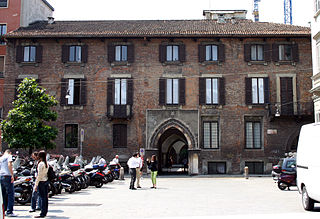
Palazzo Borromeo is a 14th-century building located at piazza Borromeo 12 in Milan, region of Lombardy, Italy. It was built as the home and business headquarters of the Borromeo family, merchant-bankers from Tuscany. Some of the building complex was badly damaged during World War II in Allied bombings of 1943 but was reconstructed and restored to its 15th-century appearance. It contains an important fresco cycle from the 1440s and is one of the finest examples of a Milanese patrician palace from the early Renaissance.

Casa Panigarola, also known as Palazzo dei Notai, is a historic building of Milan, Italy, located in Piazza Mercanti, former city centre in the Middle Ages. It is named after the House of Panigarola, a family of notaries from Gallarate, that owned the building until 1741. The building thus served as a notary seat, and the activities therein were strictly related to those that occurred in the adjacent Palazzo della Ragione, where trials were held.

Casa Campanini is an Art Nouveau building in Milan, Italy, located at 11, Via Bellini. It was completed between 1903 and 1906 by architect Alfredo Campanini, who later inhabited the building.

Neoclassical architecture in Milan encompasses the main artistic movement from about 1750 to 1850 in this northern Italian city. From the final years of the reign of Maria Theresa of Austria, through the Napoleonic Kingdom of Italy and the European Restoration, Milan was in the forefront of a strong cultural and economic renaissance in which Neoclassicism was the dominant style, creating in Milan some of the most influential works in this style in Italy and across Europe. Notable developments include construction of the Teatro alla Scala, the restyled Royal Palace, and the Brera institutions including the Academy of Fine Arts, the Braidense Library and the Brera Astronomical Observatory. Neoclassicism also led to the development of monumental city gates, new squares and boulevards, as well as public gardens and private mansions. Latterly, two churches, San Tomaso in Terramara and San Carlo al Corso, were completed in Neoclassical style before the period came to an end in the late 1830s.

Eugenio Gerli was an Italian architect and designer. In an intense working life spanning more than six decades, Eugenio Gerli explored many different areas of his profession. He built villas, apartment blocks, office blocks, factories, banks and stores, and also restored historic buildings. He often completed his works with custom-made interiors and furniture.This diverse range of projects inspired his industrial design and today many have become icons, like the S83 chair, the PS 142 armchair Clamis, the Jamaica cabinet and the Graphis System.

Palazzo Arese was a 16th century baroque palace and seat of a branch of the House of Arese in Milan, Italy. It was located adjacent to Casa Fontana Silvestri near the Porta Orientale. The palazzo was demolished in 1943 following damage sustained during the bombing of Milan in World War II.

Giuseppe Palanti was an Italian painter, illustrator, and urban planner, best known for his portraits, notably of Mussolini and Pius XI. He had a long collaboration with Teatro alla Scala in Milan, creating costume, set design and advertising material for multiple opera productions. He was also a major contributor towards the development of the seaside resort Milano Marittima.

Alessandro Mazzucotelli was an Italian craftsman, particularly known as a master ironworker and decorator. A specialist in wrought iron, Mazzucotelli linked his fame to the decorations of the works of the major exponents of Art Nouveau in Italy and abroad.

Art Nouveau in Milan indicates the spread of such artistic style in the city of Milan between the early years of the 20th century and the outbreak of the First World War. In the Lombard capital, art nouveau, called StileLiberty in Italian, found—thanks to its close relationship with the rampant industrial bourgeoisie of the time—a fertile ground for its rapid development, during which it oscillated between the influences of French Art Nouveau, German Jugendstil and eclecticism.

Casa Broggi is a monumental building located at the intersections of Via Dante, Via Meravigli, and Via Santa Maria Segreta, at the northwest end of Piazza Cordusio in Milan. The polygonal palace has facades on the three streets mentioned above with the most scenic being the narrow edge on Via Meravigli. The structure was built for multiple use, with ground floor shops and residential apartments on the higher floors. The site had once housed the church of San Nazaro in Pietrasanta, which had been demolished in the late 19th century.

Palazzo Visconti di Grazzano, also known as Palazzo Visconti di Modrone or Palazzo Bolagnos, is a historical palace located in the centre of Milan, in Via Cino del Duca no. 8.
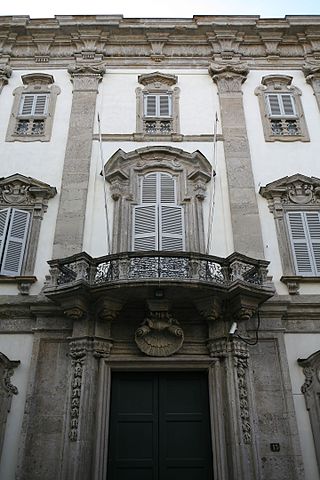
Palazzo Cusani is a 17th-century palace in Milano, remodelled a first time between 1712 and 1719 and a second time between 1775 and 1779. Historically belonging to the sestiere of Porta Nuova, it is located at via Brera 13–15.
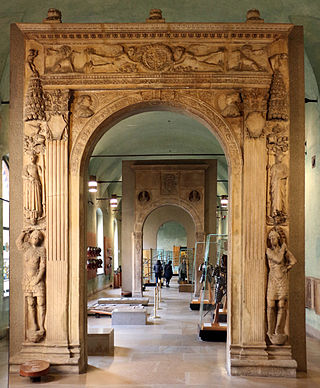
The Palazzo del Banco Mediceo or simply Banco Mediceo, was a palace in Milan, the Milanese seat of the Medici's financial exchange activities, known throughout Europe as the Medici Bank. It was one of the earliest examples of Lombard Renaissance architecture.
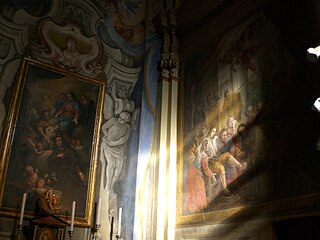
Although it has been characterized in recent centuries as an essentially industrial city, Busto Arsizio counts among its most valuable buildings the numerous monuments of an ecclesiastical nature, testifying to the deep religiosity of its people. Of particular note are the Sanctuary of Santa Maria di Piazza, the Basilica of St. John the Baptist, and the Church of San Michele Arcangelo.
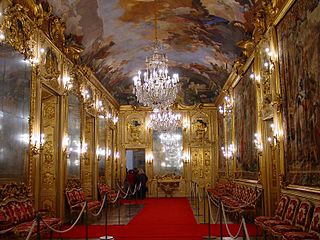
Milanese Baroque refers to the dominant artistic style between the 17th century and the first half of the 18th century in the city. Due to the work of the Borromeo cardinals and its importance in the Italian domains, at first Spanish and then Austrian, Milan experienced a lively artistic season in which it assumed the role of the driving force behind Lombard Baroque.

Via XX Settembre is one of the main thoroughfares in the center of Genoa, Italy, located within the San Vincenzo district. It is slightly less than a kilometer long.

The Grand Hotel Campo dei Fiori is a hotel located on Monte Tre Croci, in Campo dei Fiori, Varese, Italy. It was designed by Giuseppe Sommaruga between 1908 and 1912. It is in the Art Nouveau style. It was closed in 1968. As of 2024, it is in a semi-abandoned state. It is opened two or three times a year by the FAI.

The architectural and artistic presence in Milan represents one of the attractions of the Lombard capital. Milan has been among the most important Italian centers in the history of architecture, has made important contributions to the development of art history, and has been the cradle of a number of modern art movements.





















